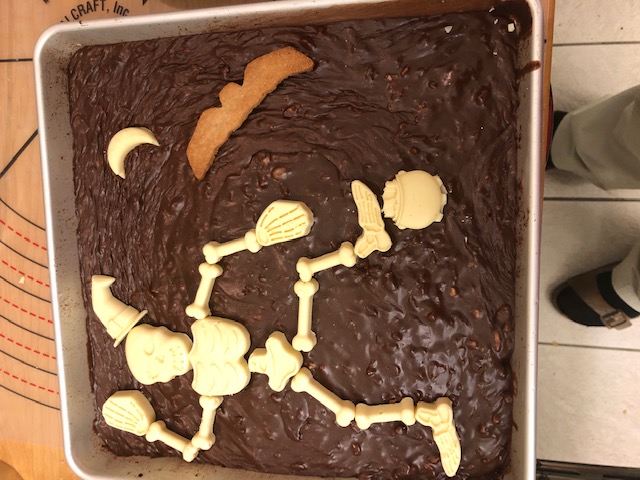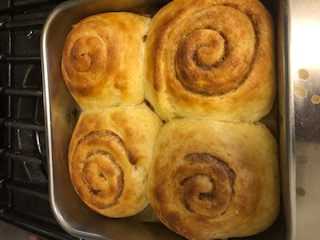Forum Replies Created
-
AuthorPosts
-
I think I'm currently using the KAF weights in my tool for flour, but the USDA weights for most everything else.
I'm not color blind, but my wife says I'm color indifferent. I do know that my left eye see somewhat different shades of color than my right eye, and I honestly don't know which one is 'correct'.
One of my college friends applied for a summer job at a paint factory. They gave him a color matching test, 100 color samples that you had to match up correctly. He said it was really challenging as it went along, as you weren't allowed to change any of your previous choices so your subsequent matches got strange as you had to pick the best choice from the remaining colors, because you couldn't pick the same 'matching' color twice.
Pastry flour is made from a soft wheat, that's why it is so much lower in protein.
As I understand it, white wheat has both soft and hard varieties, though I think the soft varieties are less common. I also think the soft varieties of white wheat aren't quite as soft as the ones used for pastry flour and the hard ones aren't quite as hard as the hardest of red wheat varieties.
My experiences with dough shaping lead me to think that if the flour is too strong, the dough fights the shaping. I think that would include cutting with a Kaiser roll stamp.
I have always thought that the reason first clear flour was used for rye bread was that it isn't pure white (more of a pale yellow or cream color) but when mixed with rye flour that didn't matter since the rye flour is much more towards brown. First clear flour was once less expensive than patent flour, though that's not true today, at least not unless you can buy a big bag of it, and maybe not then, either. This may be because flour milling has changed over the years, clear flours used to be important intermediate stages in the milling process, I'm not sure that is true any more.
Another thing to be aware of with first clear flour is that everything I've made with it has been prone to go moldy quicker than if made with patent flour. I'm not sure why, something to do with increase bran or germ, I suspect, or maybe higher ash levels. But unless I'm concerned with having a white color, I do like the taste of products made with first clear flour.
I don't see what the point to having caraway in a rye starter would be. A starter is all about enzymes, yeasts and bacteria, and caraway isn't really contributing to those.
The challenge with standardizing volume to weight measures is that nobody agrees on how much a cup of flour should weigh. King Arthur uses 4.25 ounces for AP flour, the USDA database uses 125 grams (4.41 ounces). Other authors use a number anywhere from 4 ounces per cup to 5, and I've seen a few that appeared to use 5.25 ounces per cup.
Other ingredients have similar problems.
For example, while table salt is fairly standardized, kosher salt is not, because the crystal sizes vary from one brand to another. A tablespoon of kosher salt is about the same weight as 2 to 2 1/2 teaspoons of table salt. Morton Salt advises against using kosher salt in baking. About the only advantage I see to using kosher salt in baking is that it isn't iodized. Some people can detect a bitter metallic taste with iodized salt though I can't say I've noticed it.
I've been building a tool for entering recipes that has baker's math capabilities, so I've been trying to decide on what standard volume-to-weight measurements to use in it. I need to do some work on it, I updated the PHP software on my server a while back and that broke some things in my program, which is mainly a proof-of-concept tool at this point, I need to expand the food database it has, too.
Another challenge is rounding errors. Consider table salt. USDA says a teaspoon of salt weighs 6 grams. It also says a cup of salt weighs 292 grams. 6 x 48 = 288, so there's a 1.3% difference. But nobody is likely to want to measure 6.0833 grams of salt. (Many of our small measuring spoons are grossly inaccurate, but that's a separate problem.)
A lot of bread formulas in baker's math format specify 2% salt. I suspect that's another form of rounding error. I've not checked the scientific literature to see if anybody's done a study of how much salt bread 'should' have, but 2% is a convenient number to use.
The nutrition labels required in the USA exacerbate this problem, both because of how they round to whole integers and what they say a portion size is. For flour, a single serving is usually 1/4 cup, which is generally either 29 or 30 grams. So a cup of flour would weigh either 116 or 120 grams. (As noted earlier, the USDA database says a cup of flour weighs 130 grams.)
People have done studies of how much yeast to use, but that gets into time vs flavor trade-off issues, which are separate from volumetric concerns.
I think sifting whole wheat flour would remove the biggest pieces of bran and germ. I've done that a few times myself, I think it makes for a slightly less 'toothy' bread. It would also lower the protein content a little.
I've actually run some of my freshly milled flour through a fairly fine screen mesh (at least 25 wires to the inch, I've also got one that is 40 wires to the inch), it isn't quite the same as having bolting screens, but it is the best I can do at this time. (The biggest problem is that it creates a LOT of dust.)
I made two Texas Chocolate Sheet Cakes, one 10 x 10 that is for my wife's office and one 8 x 8 for us.
To decorate them, I found a silicone mold for skeleton parts and made two skeletons with white chocolate.
I also made a recipe for ossi dei morti that is different than the one I made a couple of years ago. It doesn't have any leavening in it so they're really solid almond cookies with some cinnamon and clove in it, and a bit darker in color. I made a variety of Halloween shapes, including some tombstones that I hoped would go in the cake, the rest will probably go on a plate for people to eat. (Couldn't find space for the tombstones.)
Attachments:
You must be logged in to view attached files.We had salad with tuna fish tonight.
We had salad with tuna fish tonight.
I saw a few issues in the grocery store, but none of them tempted me to buy them.
Magazine publishing is a tough business these days. Younger people don't read printed material much, they just look online, where recipes are usually free anyway.
I've not found a subscription recipe site that I thought was worth the money. I follow the recipes and reviews on the Washington Post site, which is behind their paywall, but that's not the reason I subscribe. They usually have two dozen or so Christmas cookie recipes that they post around Thanksgiving, I've probably printed out two dozen of them, made 10-15 of them, 3 or 4 were keepers as far as I was concerned.
I've never used a Kaiser roll stamp, I have made Kaiser rolls using the fold method a number of times, it always takes me 4 or 5 rolls before I get the knack down again, so I usually make a few, throw them back in the bowl and do them again.
I think you don't want to use too strong of a flour for Kaiser rolls, I looked on the BBGA site and the Kaiser roll recipe there is 55% high extraction flour (or sifted whole wheat) and 45% 'bread flour' with a note that says 11.5 to 11.7% protein. The rest of the formula is 61% water, 2% salt, 1% yeast, 4% egg, 2.8% sugar and 2.8% oil. Use 90 grams (3.17 ounces) of dough for each roll and let them rest for 20 minutes before using the stamp. The way this recipe gets the seeds to stick is to moisten the top with a wet towel then dip the roll in seeds.
For those who don't want to do the baker's math, here's the recipe sized for 12 rolls:
341 grams high extraction/sifted whole wheat flour
279 grams AP flour (11.7% protein)
379 grams water
12.4 grams salt
6.2 grams instant dry yeast
24.8 grams egg
17.4 grams sugar
17.4 grams vegetable oilNot sure about baking temp/time, the recipe calls for 20 minutes at 400 degrees in a convection oven with steam.
It is pretty close to that, but there are times when the roughly 4% difference might be relevant.
It is worth noting that 1 ml of water = 1 gram only under the specified conditions of temperature and atmospheric pressure, as well as the purity of the water, including dissolved gasses in it.
For years the definition of a meter was based on a master standard bar locked up in a Paris vault. However, that bar became distorted over time and as a result scientists recently adapted a new standard for length, one based on a reproducible physical property.
There's snow in our forecast, and the radar screen looks like it'll be here soon, though this is likely to just be a light dusting. We may get 1-2 inches on Wednesday, though, and the forecast for Halloween is more snow in the morning and cold in the evening.
We're having a lavash pizza for supper.
We had leftover chili with the cinnamon rolls.
Those are fun.
My wife was suggesting I make a Texas Chocolate Sheet cake and use it as the 'ground' for a Halloween tableau. Not sure my cake decorating skills are up to that, though.
Here's a photo of my cinnamon rolls, they came out a lot like Chelsea buns.
I'd be tempted to make them a bit smaller next time, maybe 6 or 9 to a batch instead of 4. My wife thinks they need more cinnamon, she thinks most cinnamon goods need more cinnamon.
Attachments:
You must be logged in to view attached files. -
AuthorPosts

